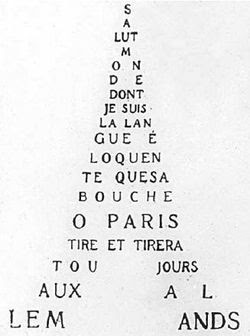Artists Among Poets - Cubism
In cubist artworks, objects are broken up, analyzed, and re-assembled in an abstracted form—instead of depicting objects from one viewpoint, the artist depicts the subject from a multitude of viewpoints to represent the subject in a greater context. Often the surfaces intersect at seemingly random angles, removing a coherent sense of depth. The background and object planes interpenetrate one another to create the shallow ambiguous space, one of cubism's distinct characteristics.
The Programme - Georges Braque

Cubist words
In 1911, Braque started to introduce letters and words into his compositions, first as stencils, then rendered freehand. Picasso was soon doing the same, and Cubist compositions began to fill up with texts derived from newspaper mastheads, bottle labels and the typography of musical scores.
A few months after the appearance of these painted verbal signs came the collages, in which actual pieces of newsprint, real labels, and advertisement, calling cards, tickets and various other extraneous elements, such as wallpaper, sandpaper and cigarette butts, were glued to the surface of the canvas or paper.
Rather than seeing this texts as things to be read, Braque said he intended them to serve a purely format purpose, as compositional devices or spatial figures that draw attention to the textuality of text and highlight the visible nature of writing as a graphic mark.
Landscape with Posters, Sorgues - Picasso, 1912

Deciphering text fragments
Although texts in Cubist works might invite readership, what kind of relationship do the fragments actually establish with the viewer/reader? Are these texts meant to be making specific commentaries on the social lives of the artists? Or, when they refer to the context of current events –political, social, economic—is some implied or explicit judgment then being made by the artist?
If we acknowledge that the various texts are in some way voices, then who exactly can be said to be speaking? Do the often multiple fragments of newsprint, the headlines, denser areas of type and advertisements add up, perhaps to a cacophony of voices, to raucous arguments, heated debates, or intimate conversations taking place in a café or studio?
Portrait of Gertrude Stein - Picasso
Gertrude Stein Reading
Cubism in Literature
The written works of Gertrude Stein employ repetition and repetitive phrases as building blocks in both passages and whole chapters. Most of Stein's important works utilize this technique. Not only were they the first important patrons of Cubism, Gertrude Stein and her brother Leo were also important influences on Cubism as well. Picasso in turn was an important influence on Stein's writing.
The poets generally associated with Cubism are Guillaume Apollinaire, Jean Cocteau, Max Jacob, André Salmon and Pierre Reverdy. As American poet Kenneth Rexroth explains, Cubism in poetry "is the conscious, deliberate dissociation and recombination of elements into a new artistic entity made self-sufficient by its rigorous architecture. This is quite different from the free association of the Surrealists and the combination of unconscious utterance and political nihilism of Dada."[11] Nonetheless, the Cubist poets' influence on both Cubism and the later movements of Dada and Surrealism was profound; Louis Aragon, founding member of Surrealism, said that for Breton, Soupault, Éluard and himself, Reverdy was "our immediate elder, the exemplary poet.
Wallace Stevens' "Thirteen Ways of Looking at a Blackbird" is also said to demonstrate how cubism's multiple perspectives can be translated into poetry.
Calligramme - Apollonaire
